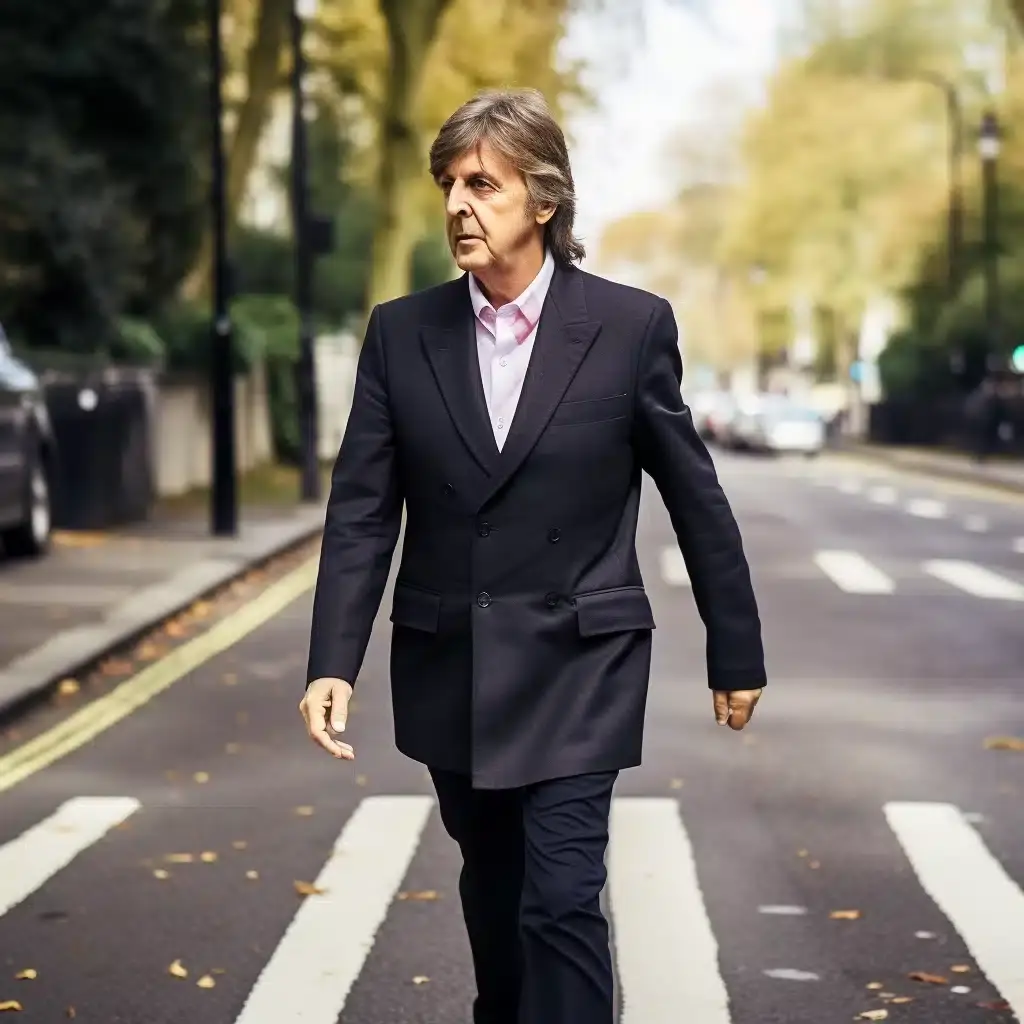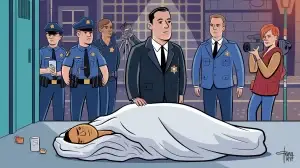Paul McCartney Death Hoax: Some rumors just can’t be let it be, and among the most whimsically bizarre tales of rock ‘n’ roll lore is the “Paul is dead” conspiracy. This tall tale suggests that Paul McCartney, the iconic bassist and singer of The Beatles, shuffled off his mortal coil in 1966 and was replaced by an imposter who was just as musically gifted and apparently just as charming. Like the best of urban legends, it started with a whisper and grew into a chorus of believers and skeptics, fully fueled by enigmatic album covers and backward-recorded messages.

Evidence for McCartney’s untimely demise and subsequent doppelganger ranged from the cryptic to the ridiculous, with fans poring over album artwork and lyrics for clues. The Abbey Road cover alone, featuring a barefoot McCartney out of step with his bandmates, served as a veritable Da Vinci Code for the 60s music scene. The legend became a pop culture phenomenon, inviting a mixture of horror, intrigue, and giggles over the claim that, if you play “Revolution 9” backwards, hidden messages affirm the hoax.
Though clearly alive and well, McCartney has taken the claims in stride, even poking fun at the unlikely story that he himself reads with a mix of amusement and bewilderment. And, in keeping with Beatlemania’s enduring grip, the rumor that once had fans combing through vinyl grooves continues to fascinate, as new generations discover the quirky anecdote that keeps the legacy of The Beatles as winding and enigmatic as the long and winding road itself.
The Birth of a Bizarre Tale

Get ready for a trip down the rabbit hole of rock ‘n’ roll lore. This bizarre tale takes root in a combination of misunderstood lyrics, visual clues embedded in album artwork, and enough speculation to fuel a Beatles bonanza of conspiracy theories.
Strawberry Fields Forever: The Accidental Origins
In what could be the ultimate musical “I buried Paul” moment, John Lennon’s enigmatic mutterings at the end of “Strawberry Fields Forever” sparked a wildfire of speculation. Was he grieving for his lost bandmate? Here’s the skinny: listeners spun a yarn that John himself, amid his avant-garde mumblings, accidentally let slip a rumor as seismic as a car crash—Paul’s untimely demise. As tall tales often do, this one snowballed and *The Beatles’ * fans searched for “evidence” with the fervor of amateur detectives.
Revolution 9 and Abbey Road: Pictorial and Audio ‘Evidence’
The “Paul is dead” crusaders went vinyl-combing through later albums for proof of their macabre theory. The Beatles’ “Revolution 9” played backwards transformed into a creepy soundtrack supposedly revealing the phrase, “Turn me on, dead man.” Talk about a backmasking bonanza! If that wasn’t enough, fans dissected the Abbey Road cover, where a suited Paul—sans shoes—paraded across the street like the proverbial duck in a shooting gallery, hinting he’s out of step with the living. They claimed his bare feet signified a corpse; the license plate “LMW 281F” whispered the age Paul would never see. And let’s not forget the left-handed bass on the grave-like image on the band’s final album “Let It Be”. Who needs a movie when you can have an album cover teeming with conspiracy Easter eggs?
‘Paul Is Dead’: Clue Analysis
The “Paul is Dead” conspiracy theory spun intricate yarns through subtle hints across Beatles albums. Fans claimed these clues could be woven into a tapestry of evidence suggesting Paul McCartney had passed away. Let’s dissect this musical mystery as a detective would, magnifying glass in hand and tongue in cheek.
Sgt. Pepper’s Lonely Hearts Club Band: A Treasure Hunt of Hints
The Sgt. Pepper album cover is like a Where’s Waldo for conspiracy theorists—except instead of Waldo, they’re searching for signs of McCartney’s untimely demise. Firstly, there’s Paul’s hand over his head, which some claim is a symbol of death in certain cultures. Then they have him holding a cor anglais, which is a woodwind instrument but, of course, could only mean he’s about to play a solemn tune in the afterlife.
The White Album’s Enigmatic Messages
On The White Album, clues are as hidden as a chameleon in a bag of Skittles. Fans played “Revolution 9” backward and were convinced it repeated “turn me on, dead man.” And let’s not overlook that the band’s name, when stretched across from John Lennon’s white suit in the poster, supposedly forms a funeral procession—because that’s what bands do when they’re bored, apparently: morbid Easter eggs.
Abbey Road: Iconic Album Cover Conspiracies
Lastly, the Abbey Road cover is a smorgasbord of cryptic signals. McCartney barefoot? Clearly a sign of a corpse being prepared for burial, not just a man enjoying a barefoot stroll on a warm day. His different stride from the others? Obviously, march of the dead man walking (or not walking). No clues on why John Lennon appears in a white suit again—perhaps laundry day coincided with the photo shoot?
The ‘Replacement’ Theory
The ‘Paul is dead’ conspiracy takes a twist on the idea of a doppelganger with the emergence of a certain William Campbell, who some believe had some rather big, Beatle-sized shoes to fill.
Enter William Campbell: The Man Who Became Paul?
Legend has it, a lookalike contest winner named William Campbell took over Paul McCartney’s life post-1966. Billy Shears is the name whispered among those in the know—or those who think they are. Whether it’s truth or the result of a few too many spins of “Sgt. Pepper’s Lonely Hearts Club Band,” the idea that this William stepped into McCartney’s not-so-yesterday shoes has been a tale of tall proportions.
Facial Clues and Forensic Speculation
The truth seekers don’t stop at a simple switch. No, they’ve scoured photos for facial clues, even leveraging forensic analysis as if it were a Sherlock Holmes mystery on a magical mystery tour. Ears and teeth became subjects of scrutiny with comparisons often drawn from before and after 1966—albeit with a pinch of speculation and a twist of intrigue. But despite such meticulous inspection, not all is what it seems on the Abbey Road of truth.
Media Mayhem and Public Frenzy

When a wild theory hit the airwaves of a Detroit radio station, it sparked a whimsical whirlwind of conspiracy that caught the public’s imagination.
Detroit Radio Station Fuels the Fire
One Sunday in 1969, Russ Gibb, a DJ at Detroit’s WKNR, received a call that turned into the epicenter of musical myth-making. A fan insisted that clues hidden in The Beatles’ music and album artwork suggested that Paul McCartney had met an untimely demise. With jokes and jabs, they combed through songs seeking “evidence,” transforming a regular broadcast into a Beatles bonanza which led fans to believe the unthinkable—that Paul had left the building, permanently.
Life Magazine Responds: Exclusive Paul McCartney Interview
Not to be outdone by radio riddles and cryptic covers, Life magazine leapt into the fray with an exclusive interview to quash the quips. In November 1969, they tracked down Paul McCartney at his Scottish farm. He was alive and well—much to the disappointment of conspiracy enthusiasts. Life magazine’s front-page feature headlined “Paul is still with us” with McCartney’s face smirking at the ballyhoo, turned the tide of public perception and restored a semblance of sanity to Beatlemania.
Beatlemania’s Response to the Hoax

When the whispers of Paul McCartney’s supposed demise hit the airwaves, Beatlemania went into overdrive. Fans combed through album covers for clues, and the media frenzy reached a fever pitch.
The Beatles’ Press Office and Public Statements
The Beatles’ Press Office, steered by the quick-witted Tony Barrow and later by the savvy Derek Taylor, found themselves navigating through the choppy waters of a death hoax. They issued a mix of bemused and deadpan denials. “Rumors of Paul McCartney’s death have been greatly exaggerated,” they might have said, paraphrasing Mark Twain, if they fancied a bit of literary humor to calm the storm. Their public statements playfully assured fans that the beloved Beatle was, in fact, alive and well.
Messages to the Fans Through Music
In response to the hullabaloo, Beatles songs reportedly carried secret signals. In “Glass Onion,” John Lennon cheekily sang, “Well, here’s another clue for you all, the walrus was Paul,” tossing a playful wink to the conspiracy theorists. McCartney himself would later poke fun at the rumors in his solo work, cementing the legend within pop culture lore. The music became a playful back-and-forth; a coded conversation between the Beatles and their fans.
Unraveling the Conspiracy
In 1969, the rumor that Paul McCartney had met an untimely demise and been replaced by a doppelganger sent fans into a tailspin. This section peels back the layers of the “Paul is dead” theory, digging into the logical and expert analyses that have endeavored to put this legendary musical myth to rest.
Logical Explorations and Deductions
One might say that the conspiracy theorists dissecting Beatles albums for “clues” had more time on their hands than a watchmaker. The tales spun around reversed audio messages, cryptic album cover symbolism, and Paul McCartney’s barefooted appearance on the Abbey Road cover are imaginative, to say the least. However, skeptics point to the fact that humans are pattern-seeking creatures, often finding connections where none exist. Logical deductions would argue that it’s highly improbable that such a high-profile switch could take place unnoticed, yet many fans scrutinize records and photos like they’re scouring for Waldo.
- Clue Examination:
- Abbey Road Cover: Analyzed for the supposed funeral procession depiction.
- Audio Tracks: “Revolution 9” and “I Am the Walrus” played backwards for hidden messages.
Expert Opinions on the Hoax Theory
Scholars and Beatles experts have chimed in on the matter, often with a chuckle. Drake University and Fred Labour, credited with propelling the theory from a humorous article in The Michigan Daily, likely didn’t anticipate becoming footnotes in one of the biggest hoax theories in music history. Experts argue that the social climate of the late ’60s, ripe with skepticism towards authority, fostered an environment in which such conspiracy theories could flourish. They also highlight that critical and logical assessment of the supposed “evidence” does not support the conclusion that McCartney died in 1966. Instead, the surviving Beatle’s continued career and public appearances put this persistent conspiracy theory on shaky ground.
- Expert Statements:
- The Michigan Daily: Recognized as the catalyst for the widespread rumor.
- Fred Labour: Labour later acknowledged the article’s satirical intent.
Hoax Aftermath and Cultural Impact

Following the whirlwind of rumors and conspiracy theories about Paul McCartney’s supposed demise, the cultural landscape was never quite the same. The hoax sparked a legendary urban legend that resonated through pop culture and left an indelible mark on McCartney’s career trajectory.
The Legacy of the Death Hoax in Pop Culture
Long after the rumor mills had quieted down, whispers of “I buried Paul” echoed through the halls of music history. People became amateur sleuths, pouring over album covers and songs for “clues.” The Beatles’ “Abbey Road” cover, for instance, had everyone and their grandmother putting on their detective hat, pointing out how the band members’ strides were a secret Morse code message about McCartney’s fate. It became a hobby as much as a joke for enthusiasts, and fuel for creatives everywhere, serving as a ghoulish inspiration for music, film, and literature for years to come. Satires and parodies are commonplace in the wake of the hoax, manifesting the collective tongue-in-cheek acknowledgment of the story’s far-fetched nature.
Paul McCartney’s Career Post Hoax
Despite the macabre humor surrounding the “Paul is dead” fiasco, or perhaps because of it, McCartney’s career didn’t miss a beat — it soared. Not only did he continue to make music that topped charts, he also turned the hoax on its head, having a bit of a laugh with the rumors. Songs like “Live and Let Die” and albums titled “Paul Is Live” were McCartney’s way of winking at the oddity of the situation. Cultural impact, you say? Sir Paul became the musician who not only outlived his fictional death but also leveraged it as part of his brand. Conspiracy theorists inadvertently boosted his mystique, ensuring that Paul McCartney (and his doppelgänger theories) remained a hot topic amongst music fans, and secured a quirky footnote in rock ‘n’ roll history.
Conclusion: The Continuing Life of a Legend

Despite the hilarious notion that he might have been secretly replaced following a supposed 1966 car accident, Paul McCartney has emphatically outlived the Paul is dead hoopla. The Beatles album covers, thoroughly dissected for ‘clues’, have become a treasure hunt for fans with a penchant for the whimsical. McCartney has since been seen strutting across zebra crossings and raising eyebrows, all while very much alive.
He not only survived the 60s, but flourished, cheekily naming a live album “Paul is Live“, poking fun at the decades-old conspiracy theory. His solo albums quietly whisper, “Not only am I breathing, but I’m also producing hits!”
In the rolling green pastures of Scotland, McCartney might chuckle to himself, crafting melodies that further cement his legendary status. The cheeky lad from Liverpool continues to sing, compose, and perform, demonstrating that rumors of his demise were greatly exaggerated.
While the man himself has outlasted the frenzy, the McCartney mythos invites a chuckle or two as it adds flavor to an iconic musical journey. The legend of McCartney’s ‘death’ has become an odd footnote in the story of a man whose career has been anything but dead.
Steve is the creative force behind My Unique Tales, a blog dedicated to sharing captivating stories that explore the human experience in all its complexity. With a passion for writing and a talent for crafting engaging narratives, Steve's blog is a treasure trove of imaginative tales that transport readers to other worlds and challenge them to see things from new perspectives. From epic adventures to intimate character studies, Steve's stories are always thought-provoking and emotionally resonant. With a growing following of readers who appreciate his unique voice and creative vision, Steve is quickly becoming a rising star in the world of online storytelling.






